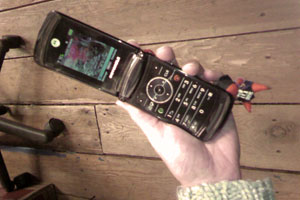And this "duh" is exactly what seemed kind of profound: we take communication for granted. Of course we can talk to each other and share things with each other. And of course we create new devices to make talking and sharing easier. Of course.
But why do we do this, seemingly to no end? And why is it that communication is such a vital and defining aspect of our experience as humans? Why, really, do I love my cell phone so much?
I think it's genetic.
It's probably not news to most of you that we humans appear to be wired to talk to each other. We've got that FOXP2 gene that keeps making the news, contributing to our linguistic capacity. In fact, many researchers believe that language was central to our success as a species and allowed a small group of humans to expand across the globe about 50,000 years ago.
Our genetic design for interaction seems to go beyond talking amongst ourselves. A University of Michigan study slated to be published next month found that social interaction has a positive affect on memory and on cognitive functioning. The people who had the most conversations with others seemed to be the sharpest, and this was particularly true among young people. This may mean that more socially-oriented humans had a bit of an advantage over those who tended to keep more to themselves.
We may be such social animals that we're even hard-wired to simply need company. After all, isolation is one of the most universal methods of punishment. Another set of researchers at the University of Illinois at Chicago found that mice isolated from their comrades have lower levels of hormones that control anxiety, depression, and aggression. They believe that these responses are similar in humans. In other words, it's possible that our brains keep us happier and functioning better when they're interacting with other brains.
It makes sense that our predecessors who figured out how to play well with others and share their thoughts were the ones who got the best shot at passing on their genes. And it's no wonder our species devotes such enormous reserves to inventions that make communication easier. The most basic systems of rock painting and alphabets have allowed groups to share stories or warn others of impending trouble. And creations that help disseminate these symbols--papyrus, the printing press, even the simple pen and paper--have had a major impact on how we exist with one another, as individuals and as societies.
These days, many of our communication technologies have gone beyond "watch for hungry bear" or "here's my idea" into doing a kind of doubly-human duty. We not only use technology to convey thoughts, but also to extend our opportunities to create bonds with other people and to form social groups. Thus the popularity of the likes of Facebook, personals ads, and Flickr. In fact, if you leave a comment about this little ditty I've written, you've hopped on this double-duty train by becoming a part of Quest's blogging community.
And so now, as my thumbs feverishly tap out text messages, I see my cell phone as more than a gadget. It's the latest cousin of cave drawings and hieroglyphics. What it says about my own evolution I'm not quite certain. But no doubt my wireless admiration results from something buried in my chromosomes.
 Robin Marks is a journalist and science writer who current serves as a Multimedia Projects Developer for the Exploratorium in San Francisco, CA.
Robin Marks is a journalist and science writer who current serves as a Multimedia Projects Developer for the Exploratorium in San Francisco, CA.
latitude: 37.7595, longitude: -122.51
37.83305 -122.44222
 Let me explain. On New Year's Eve I brought my phone with me to San Francisco's Ocean Beach, where I traditionally go, rain or shine, to watch the year's last sunset. I was by myself, but I wasn't alone.
Let me explain. On New Year's Eve I brought my phone with me to San Francisco's Ocean Beach, where I traditionally go, rain or shine, to watch the year's last sunset. I was by myself, but I wasn't alone.